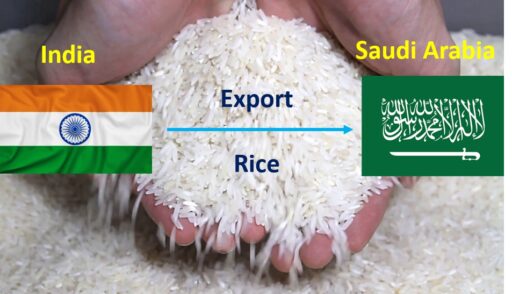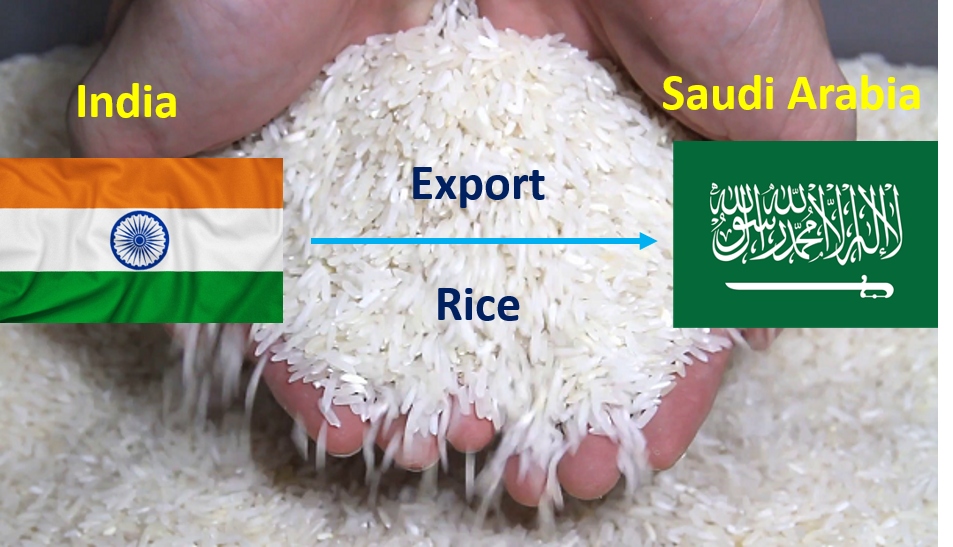Introduction to Rice Trade between Saudi Arabia and India
Rice is a staple food in Saudi Arabia, and the country relies heavily on imports to meet its domestic demand. India, being one of the world’s largest rice producers and exporters, has emerged as a significant trade partner for Saudi Arabia in the rice market.
The rice trade relationship between Saudi Arabia and India is crucial for ensuring food security in the Kingdom. With a growing population and limited arable land, Saudi Arabia has a high dependency on imported rice to fulfill its consumption needs. On the other hand, India’s vast agricultural resources and favorable climate conditions make it an ideal source for rice exports.
India’s position as a leading rice exporter is further strengthened by its diverse rice varieties, competitive pricing, and efficient production methods. The country’s ability to consistently produce high-quality rice in large quantities has made it a preferred supplier for many rice-importing nations, including Saudi Arabia.
For Saudi Arabia, importing rice from India not only ensures a stable supply of this essential food item but also contributes to the diversification of its import sources. By strengthening trade ties with India, Saudi Arabia can mitigate potential risks associated with relying on a single source for its rice imports.
Rice Consumption and Demand in Saudi Arabia
Saudi Arabia has a significant demand for rice due to its large population and dietary preferences. Rice is a staple food in the Saudi diet, consumed in various forms such as biryani, kabsa, and other traditional dishes. The country’s domestic rice production is limited, and it relies heavily on imports to meet the growing demand.
The population of Saudi Arabia has been steadily increasing, with a current population of over 35 million people. This population growth, coupled with urbanization and changing lifestyles, has led to a rise in rice consumption. Additionally, the Saudi Arabian government has implemented policies to ensure food security and diversify the country’s food sources, further driving the demand for rice imports.
Saudi Arabians have a strong preference for long-grain basmati rice, which is widely used in their cuisine. This preference has created a niche market for high-quality basmati rice imports from countries like India and Pakistan. However, other rice varieties, such as jasmine and parboiled rice, are also gaining popularity due to their unique flavors and nutritional benefits.
The domestic production of rice in Saudi Arabia is limited due to the arid climate and scarcity of water resources. As a result, the country relies heavily on imports to meet its rice demand. In recent years, Saudi Arabia has imported rice from various countries, including India, Pakistan, Thailand, and the United States, among others.
India’s Rice Production and Exportation
India is one of the world’s leading producers and exporters of rice. The country’s vast agricultural lands, favorable climate, and advanced farming techniques contribute to its significant rice production. India cultivates a wide variety of rice, including basmati, a long-grain aromatic rice highly prized for its flavor and aroma.
India’s rice production is concentrated in several states, with West Bengal, Uttar Pradesh, Punjab, and Andhra Pradesh being major contributors. The country’s rice cultivation practices have evolved over time, incorporating modern irrigation systems, high-yielding seed varieties, and sustainable farming methods.
The quality of Indian rice is renowned globally, and the country adheres to stringent quality standards. Basmati rice, in particular, is subject to rigorous quality control measures, ensuring its distinctive aroma, elongation after cooking, and superior taste. India’s rice exports undergo thorough inspection and certification processes to meet international quality and safety requirements.
In addition to basmati, India exports various other rice varieties, including non-basmati long-grain rice, parboiled rice, and specialty rice varieties like sona masoori and ponni. These rice varieties cater to diverse consumer preferences and culinary traditions worldwide.
India’s rice exports have witnessed steady growth over the years, driven by increasing global demand and the country’s competitive pricing. Major export destinations for Indian rice include the Middle East, Southeast Asia, Europe, and North America. The government of India actively promotes rice exports through various policies and initiatives, supporting farmers, millers, and exporters.
Trade Agreements and Regulations
Saudi Arabia and India have a strong trade relationship, facilitated by various bilateral agreements and regional trade pacts. The two countries are members of the World Trade Organization (WTO), which provides a framework for fair and transparent trade practices. Additionally, Saudi Arabia and India are part of the Gulf Cooperation Council (GCC) and the Asia Cooperation Dialogue (ACD), respectively, which promote economic cooperation among member nations.
In terms of rice trade, Saudi Arabia imposes a 5% import tariff on rice from India, which is lower than the rates applied to other trading partners. This preferential tariff rate is a result of the India-Gulf Cooperation Council (GCC) Free Trade Agreement, signed in 2004. The agreement aims to enhance trade between India and the GCC countries by reducing or eliminating tariffs on a wide range of goods, including agricultural products like rice.
Furthermore, Saudi Arabia has implemented the Gulf Standardization Organization (GSO) regulations, which set quality standards for imported food products, including rice. These regulations cover aspects such as labeling, packaging, and maximum residue levels for pesticides and contaminants. Indian exporters must ensure that their rice shipments comply with these regulations to gain entry into the Saudi market.
It is important to note that Saudi Arabia does not impose any quantitative restrictions or quotas on rice imports from India or other countries. However, the Saudi government may implement temporary measures, such as increasing import tariffs or imposing quotas, in response to domestic supply and demand conditions or to protect local agriculture.
Overall, the existing trade agreements and regulations between Saudi Arabia and India provide a favorable environment for rice trade, while ensuring food safety and quality standards are met. Exporters must stay updated on any changes in trade policies or regulations to ensure smooth and compliant rice imports into Saudi Arabia.
Import Procedures and Documentation
Importing rice from India to Saudi Arabia involves a series of procedures and documentation requirements. Here’s a step-by-step guide to help you navigate the process:
- Obtain Import License: Before initiating the import process, you must obtain an import license from the Saudi Arabian General Investment Authority (SAGIA) or the Ministry of Commerce and Investment. This license is essential for customs clearance and ensures compliance with Saudi regulations.
- Appoint a Clearing Agent: It’s highly recommended to appoint a licensed clearing agent or customs broker in Saudi Arabia. They will handle the documentation and customs clearance process on your behalf, ensuring smooth and efficient operations.
- Collect Required Documents: Gather the necessary documents, including the commercial invoice, packing list, certificate of origin, phytosanitary certificate, bill of lading or airway bill, and any other documents required by Saudi customs authorities.
- Submit Import Declaration: Your clearing agent will submit the import declaration along with the required documents to the Saudi Customs Authority. This declaration provides details about the shipment, including the quantity, value, and classification of the goods.
- Customs Inspection and Clearance: Saudi customs officials will inspect the shipment and verify the documentation. If everything is in order, they will issue a customs clearance certificate, allowing the release of the goods.
- Payment of Duties and Taxes: Depending on the trade agreements and regulations, you may need to pay import duties, value-added tax (VAT), and other applicable taxes. Your clearing agent can assist you with calculating and paying these fees.
- Delivery and Distribution: Once the customs clearance is obtained, the rice shipment can be released and delivered to your designated warehouse or distribution center in Saudi Arabia.
Throughout the import process, it’s crucial to maintain accurate and complete documentation. Any discrepancies or missing information can lead to delays or potential penalties. Additionally, ensure that the rice shipment complies with Saudi food safety regulations, labeling requirements, and any other relevant standards.
Quality Control and Inspection
Quality control and inspection are crucial aspects of importing rice from India to Saudi Arabia. Ensuring the quality and safety of the rice is paramount for both the importing country and the end consumers. Saudi Arabia has stringent regulations and standards in place to protect its food supply and public health.
One of the primary concerns in rice importation is the presence of contaminants, such as pesticide residues, heavy metals, or microbial pathogens. To address this, India and Saudi Arabia have established phytosanitary measures and protocols to ensure the rice meets the required safety standards. These measures may include pre-shipment inspections, laboratory testing, and certification requirements.
Upon arrival in Saudi Arabia, the rice shipments undergo thorough inspections by the relevant authorities. These inspections typically involve physical examinations, sampling, and laboratory analyses to verify the rice’s quality, safety, and compliance with Saudi Arabian regulations. Factors such as moisture content, grain size, and the presence of foreign matter or pests are closely monitored.
In addition to the mandatory inspections, Saudi Arabian importers may also opt for voluntary certifications or quality assurance programs. These certifications, such as ISO, HACCP, or organic certifications, provide additional assurance to consumers and enhance the credibility and marketability of the imported rice.
Compliance with quality control and inspection measures is crucial for maintaining a successful trade relationship between Saudi Arabia and India in the rice sector. Failure to meet the required standards can result in rejected shipments, financial losses, and potential trade disruptions. Continuous monitoring and adherence to best practices throughout the supply chain are essential to ensure the consistent quality and safety of imported rice.
Pricing and Payment Terms
Rice prices in the global market are influenced by various factors, including supply and demand dynamics, production costs, weather conditions, and government policies. When importing rice from India to Saudi Arabia, both parties need to consider these factors to determine a fair and competitive pricing structure.
One of the key factors influencing rice prices is the quality and variety of the rice. Premium and specialty rice varieties, such as basmati rice, tend to command higher prices compared to regular long-grain or short-grain rice varieties. The pricing will also depend on the grade and processing methods used, with higher grades and more advanced processing techniques resulting in higher prices.
Production costs, including labor, fertilizers, and energy, also play a significant role in determining rice prices. India, being a major rice producer, benefits from relatively lower production costs, which can translate into more competitive pricing for its rice exports.
Government policies, such as subsidies, import tariffs, and export restrictions, can also impact rice prices. Both India and Saudi Arabia may have specific policies in place that could affect the final pricing for rice imports.
In terms of payment terms, it is common for importers and exporters to agree on methods such as letters of credit, documentary collections, or open account terms. Letters of credit are often preferred as they provide a secure payment mechanism and reduce the risk of non-payment.
Currency exchange rates are another important consideration when importing rice from India to Saudi Arabia. Fluctuations in the exchange rate between the Indian Rupee and the Saudi Riyal can impact the final cost of the rice shipment. Both parties may consider hedging strategies or incorporating currency adjustment clauses in their contracts to mitigate the risks associated with currency fluctuations.
Additionally, importers and exporters should discuss and agree on payment terms, such as the timeline for payment, acceptable payment methods, and any late payment penalties or interest charges. Clear communication and documentation of these terms are crucial to ensure a smooth transaction and avoid potential disputes.
Transportation and Logistics
Rice imports from India to Saudi Arabia involve various transportation modes and logistical considerations. The primary shipping method is via maritime transportation, with Indian rice exporters utilizing major ports like Mumbai, Chennai, and Kandla to load containerized or bulk cargo vessels destined for Saudi Arabian ports like Jeddah Islamic Port and King Abdulaziz Port in Dammam.
Saudi Arabia has made significant investments in modernizing its port infrastructure, enhancing efficiency and capacity to handle increased import volumes. These ports are equipped with advanced cargo handling facilities, including specialized equipment for bulk grain handling, storage silos, and efficient customs clearance procedures.
Once the rice shipments arrive at the Saudi ports, inland transportation plays a crucial role in distributing the imported rice across the country. Saudi Arabia’s well-developed road network and trucking industry facilitate the movement of rice from ports to various distribution centers and wholesale markets. Refrigerated trucks are often employed to maintain the quality and freshness of the rice during transportation.
In addition to road transportation, Saudi Arabia’s railway network can also be utilized for inland distribution, particularly for larger volumes destined for major cities and industrial hubs. This multimodal approach combines the cost-effectiveness of maritime shipping with the flexibility of inland transportation modes.
Distribution channels for imported rice in Saudi Arabia involve a network of wholesalers, retailers, and specialized rice traders. Large-scale importers and distributors often have well-established relationships with retailers, supermarkets, and traditional markets, ensuring efficient distribution and availability of rice across the country.
Overall, the transportation and logistics involved in importing rice from India to Saudi Arabia require a coordinated effort among various stakeholders, including shipping companies, port authorities, trucking companies, and distribution networks, to ensure a seamless and efficient supply chain that meets the growing demand for rice in the Saudi market.
Challenges and Risk Mitigation
Importing rice from India to Saudi Arabia can present several challenges that importers must be prepared to address. One of the main challenges is ensuring consistent quality and food safety standards. Rice shipments may be subject to strict inspections and testing by Saudi authorities to verify compliance with regulations. Any issues with quality or contamination could result in shipments being rejected or facing costly delays.
Another challenge is navigating the complex import regulations and documentation requirements. Importers need to ensure they have all necessary permits, licenses, and certifications in order to clear customs smoothly. Delays or errors in paperwork can lead to shipments being held up or incurring additional fees.
Fluctuations in currency exchange rates and global rice prices can also pose risks, impacting the profitability of import transactions. Importers may consider strategies such as hedging or forward contracts to mitigate these financial risks.
Logistical challenges, such as transportation delays, port congestion, or issues with shipping containers, can also disrupt the rice import supply chain. Importers should have contingency plans in place and work with reliable logistics providers to minimize these risks.
To mitigate these challenges, importers should consider obtaining comprehensive insurance coverage for their rice shipments. Marine cargo insurance can protect against losses or damages during transit, while product liability insurance can provide coverage in case of any issues with food safety or quality.
Importers should also develop robust risk management strategies, such as diversifying their supplier base, maintaining adequate inventory buffers, and regularly reviewing and updating their import processes and procedures. Building strong relationships with reputable Indian rice exporters and Saudi authorities can also help streamline the import process and mitigate risks.
Future Outlook and Trends
The rice trade between Saudi Arabia and India is projected to experience significant growth in the coming years. As the Saudi population continues to expand and dietary preferences shift towards rice consumption, the demand for imported rice is expected to surge. India, being a leading producer and exporter of rice, is well-positioned to meet this increasing demand.
One emerging trend is the growing preference for premium and specialty rice varieties, such as basmati and organic rice. Saudi consumers are becoming more health-conscious and are willing to pay a premium for high-quality, nutritious rice products. This presents an opportunity for Indian exporters to diversify their offerings and cater to this niche market segment.
Furthermore, the adoption of advanced agricultural technologies and sustainable farming practices in India could lead to increased rice yields and improved quality, making Indian rice more competitive in the global market. Collaboration between the two countries in areas such as research and development, knowledge sharing, and technology transfer could further strengthen the rice trade relationship.
Potential opportunities also lie in value-added rice products, such as ready-to-eat rice meals and rice-based snacks. As the Saudi market continues to urbanize and consumer lifestyles become more fast-paced, the demand for convenient and packaged food products is likely to increase. Indian exporters who can adapt to these changing consumer preferences may find new avenues for growth.
However, it is important to consider potential challenges and risks, such as fluctuations in currency exchange rates, changes in trade policies, and logistical bottlenecks. Effective risk management strategies, such as hedging against currency fluctuations and diversifying supply chains, will be crucial for ensuring a stable and sustainable rice trade relationship between the two countries.
Overall, the future outlook for the rice trade between Saudi Arabia and India is promising, with ample opportunities for growth and diversification. By staying attuned to emerging trends, leveraging technological advancements, and fostering strong bilateral cooperation, both countries can benefit from a mutually beneficial and thriving rice trade relationship.





